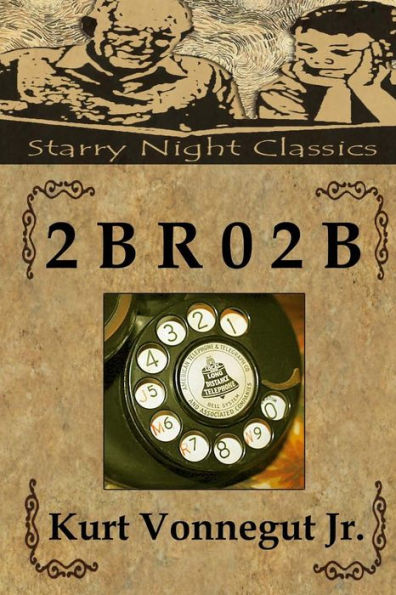

Paperback
-
SHIP THIS ITEMTemporarily Out of Stock Online
-
PICK UP IN STORECheck Availability at Nearby Stores
Available within 2 business hours
Related collections and offers
Overview
Then, one day, a woman gives birth to triplets, and two parents must choose which of their children they must give up, or take matters into their own hands. Who will dial 2BR02B, the number for the Federal Bureau of Termination?

Product Details
| ISBN-13: | 9781499202458 |
|---|---|
| Publisher: | CreateSpace Publishing |
| Publication date: | 04/19/2014 |
| Pages: | 26 |
| Product dimensions: | 6.00(w) x 9.00(h) x 0.05(d) |
About the Author

Kurt enlisted in the U. S. Army during World War II, and was transferred to the Carnegie Institute of Technology, then the University of Tennessee for mechanical engineering. On Mother's Day 1944, his mother committed suicide.
Sent into combat, due to a manpower shortage, Vonnegut was captured during the Battle of the Bulge and imprisoned in Dresden. He survived the firebombing of Dresden by the Allies, by staying in an underground meat locker, nicknamed "Slaughterhouse Five." He was freed by Russian troops in 1945 and given a Purple Heart.
After the war, he attended the University of Chicago in the graduate anthropology program and worked for the City News Bureau. Moving to Schenectady, New York, he took a job at General Electric, where his older brother worked, and served as a Volunteer Fire-Fighter.
Vonnegut worked briefly for "Sports Illustrated," then at the University of Iowa Writer's Workshop. It was there that he wrote "Cat's Cradle" and "Slaughterhouse-Five," which are considered by many to be some of the best novels of the 20th century.
After that, he moved to Cape Cod, Massachusetts and opened one of the first Saab dealerships in the country. It closed within a year. Vonnegut married Jane Marie Cox in 1946, but they separated in 1970 and divorced in 1979. They had three children.
He married Jill Krementz in 1979 and they adopted a daughter. When his sister died of cancer, they also adopted three of her four children. Kurt died on April 11, 2007, at the age of 84, in New York City, after falling down a flight of stairs at his home.
Date of Birth:
November 11, 1922Date of Death:
April 11, 2007Place of Birth:
Indianapolis, IndianaPlace of Death:
New York, New YorkEducation:
Cornell University, 1940-42; Carnegie-Mellon University, 1943; University of Chicago, 1945-47; M.A., 1971Read an Excerpt
Everything was perfectly swell.
There were no prisons, no slums, no insane asylums, no cripples, no poverty, no wars.
All diseases were conquered. So was old age.
Death, barring accidents, was an adventure for volunteers.
The population of the United States was stabilized at forty-million souls.
One bright morning in the Chicago Lying-in Hospital, a man named Edward K. Wehling, Jr., waited for his wife to give birth. He was the only man waiting. Not many people were born a day any more.
Wehling was fifty-six, a mere stripling in a population whose average age was one hundred and twenty-nine.
X-rays had revealed that his wife was going to have triplets. The children would be his first.
Young Wehling was hunched in his chair, his head in his hand. He was so rumpled, so still and colorless as to be virtually invisible. His camouflage was perfect, since the waiting room had a disorderly and demoralized air, too. Chairs and ashtrays had been moved away from the walls. The floor was paved with spattered dropcloths.
The room was being redecorated. It was being redecorated as a memorial to a man who had volunteered to die.
A sardonic old man, about two hundred years old, sat on a stepladder, painting a mural he did not like. Back in the days when people aged visibly, his age would have been guessed at thirty-five or so. Aging had touched him that much before the cure for aging was found.
The mural he was working on depicted a very neat garden. Men and women in white, doctors and nurses, turned the soil, planted seedlings, sprayed bugs, spread fertilizer.
Men and women in purple uniforms pulled up weeds, cut down plants that were oldand sickly, raked leaves, carried refuse to trash-burners.
Never, never, never--not even in medieval Holland nor old Japan--had a garden been more formal, been better tended. Every plant had all the loam, light, water, air and nourishment it could use.
A hospital orderly came down the corridor, singing under his breath a popular song:
If you don't like my kisses, honey,
Here's what I will do:
I'll go see a girl in purple,
Kiss this sad world toodle-oo.
If you don't want my lovin',
Why should I take up all this space?
I'll get off this old planet,
Let some sweet baby have my place.
The orderly looked in at the mural and the muralist. "Looks so real," he said, "I can practically imagine I'm standing in the middle of it."
"What makes you think you're not in it?" said the painter. He gave a satiric smile. "It's called 'The Happy Garden of Life,' you know."
"That's good of Dr. Hitz," said the orderly.
